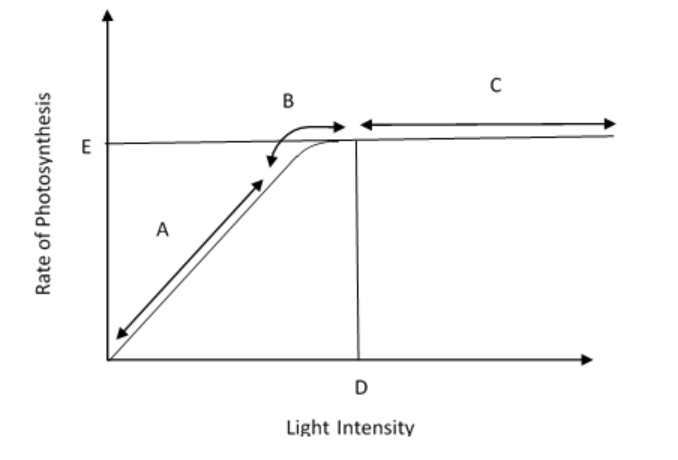
The figure shows the effect of light on the rate of photosynthesis. Based on the graph, answer the following questions:
A. At which point/s (A, B or C) in the curve is a light limiting factor?
B. What could be the limiting factor/s in region A?
C. What do C and D represent in the curve?


Answer
486.6k+ views
Hint: Limiting factor is that factor in a reaction, ecosystem etc., that is responsible for the limiting of that particular reaction (growth, distribution etc., in an ecosystem). In plants, for photosynthesis, carbon dioxide, light and temperature are the common limiting factors.
Complete answer:
As mentioned above, light, temperature and concentration of carbon dioxide acts as common limiting factors for photosynthesis. This graph represents the light intensity vs the rate of photosynthesis. As we can see from the graph, the rate of photosynthesis increases until a certain point with the increase in temperature. But after a certain light intensity at point D, the rate remains constant and does not increase any further.
Let us now try to answer the questions given above.
A. Light is a limiting factor in the region named A. Any change in the level of light at the region A will cause a difference in photosynthesis rate and hence light is a limiting factor in region A. Light is a limiting factor where photosynthesis is minimum.
B. As mentioned in the hint part, the common limiting factors that could be present in region A are temperature, concentration of carbon dioxide and light itself. The other factor could be the availability of water.
C. Point D represents the saturation point or optimum point of photosynthesis. At D and after that, the photosynthesis is maximum and light no longer behaves as a limiting factor even if the light intensity is increased after point D. The region C is the region of maximum photosynthesis where any increase in light intensity does not change the rate of photosynthesis.
Note:
Only during the steep part of the curve, light acts as a limiting factor. During the horizontal part there are factors that act as limiting factors. It is very important for commercial crop growers to reduce the limiting factors in order to increase the growth rate of the crops and increase the profits.
Complete answer:
As mentioned above, light, temperature and concentration of carbon dioxide acts as common limiting factors for photosynthesis. This graph represents the light intensity vs the rate of photosynthesis. As we can see from the graph, the rate of photosynthesis increases until a certain point with the increase in temperature. But after a certain light intensity at point D, the rate remains constant and does not increase any further.
Let us now try to answer the questions given above.
A. Light is a limiting factor in the region named A. Any change in the level of light at the region A will cause a difference in photosynthesis rate and hence light is a limiting factor in region A. Light is a limiting factor where photosynthesis is minimum.
B. As mentioned in the hint part, the common limiting factors that could be present in region A are temperature, concentration of carbon dioxide and light itself. The other factor could be the availability of water.
C. Point D represents the saturation point or optimum point of photosynthesis. At D and after that, the photosynthesis is maximum and light no longer behaves as a limiting factor even if the light intensity is increased after point D. The region C is the region of maximum photosynthesis where any increase in light intensity does not change the rate of photosynthesis.
Note:
Only during the steep part of the curve, light acts as a limiting factor. During the horizontal part there are factors that act as limiting factors. It is very important for commercial crop growers to reduce the limiting factors in order to increase the growth rate of the crops and increase the profits.
Recently Updated Pages
Master Class 11 Economics: Engaging Questions & Answers for Success

Master Class 11 Business Studies: Engaging Questions & Answers for Success

Master Class 11 Accountancy: Engaging Questions & Answers for Success

Master Class 11 English: Engaging Questions & Answers for Success

Master Class 11 Computer Science: Engaging Questions & Answers for Success

Master Class 11 Maths: Engaging Questions & Answers for Success

Trending doubts
Which one is a true fish A Jellyfish B Starfish C Dogfish class 11 biology CBSE

State and prove Bernoullis theorem class 11 physics CBSE

1 ton equals to A 100 kg B 1000 kg C 10 kg D 10000 class 11 physics CBSE

In which part of the body the blood is purified oxygenation class 11 biology CBSE

One Metric ton is equal to kg A 10000 B 1000 C 100 class 11 physics CBSE

Difference Between Prokaryotic Cells and Eukaryotic Cells




